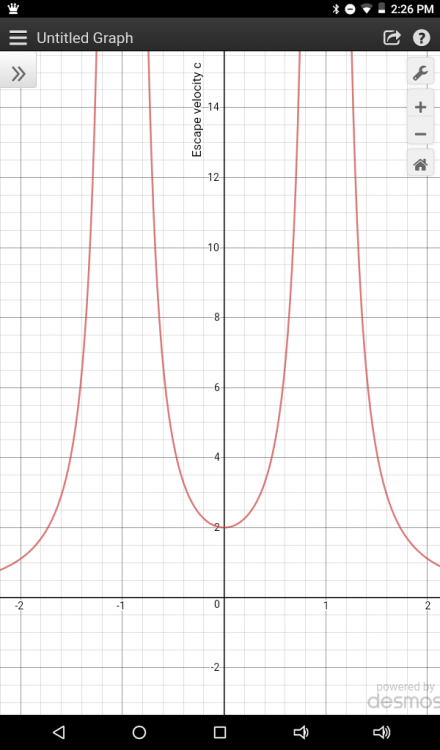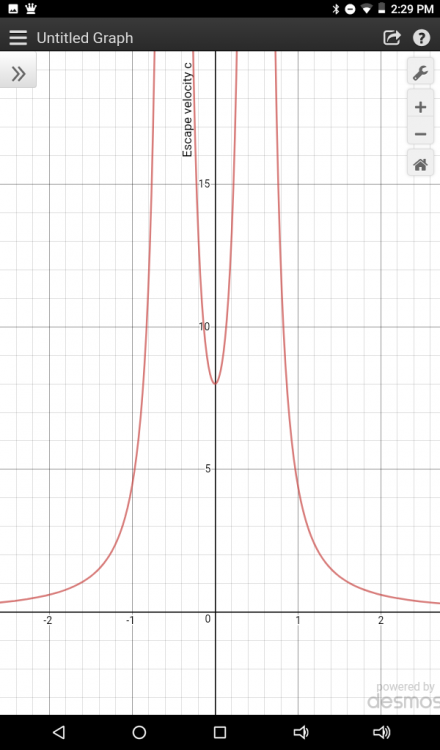-
Posts
792 -
Joined
-
Last visited
-
Days Won
1
Content Type
Profiles
Forums
Events
Everything posted by Butch
-
So, a photon with a wave length equal to one Planck length would be the greatest energy a photon could have? If so, E= mc^2 should derive to a quanta of mass?
-
The process described previously (division to a fraction) fit with Planck. Never said it had anything to do with mass, not so far anyway... That is why I am left trying to discern a quanta of mass. I do believe that the Planck length applied to photon wavelengths might provide an answer... if indeed a photon is a gravitational phenomena. The logic I am pursuing is that at some point when the wavelength shortens the photon becomes a gravitational well, that is it becomes a quanta of mass. Swansont, I recall when I first stated that a photon was a wave packet in a gravitational field you said "You will have to prove that." I appreciate that you did not discount the possibility, off the cuff. I have seen no science that says it cannot be so! Proof is something that does not exist in science. Acceptance is something I know must be earned through a great amount of work. I am doing that work and have reached a road block at the quanta of mass. Perhaps you can help me with something... I understand that Hf provides the energy of a photon... With what units? I could substitute 2 as a constant and say 2f is the energy of a photon... I know I am missing the concept here, can you help me out? I think I get it via Strange... Planck is saying that energy is in discrete levels, energy quanta? Thus the wavelength of a photon could not be less than the Planck length?
-
Does a gravitational well have mass? Does a mass have a gravitational well? Are they really different? Isn't mass just warped space?
-
Yes it is, so it must have mass! Look at it this way, the output of a wall outlet is alternating current, the average of that output is zero. If a photon were a wave in a gravitational field, it would be an expansion and contraction of that field locally. Such excitation might express negative gravity as well as positive gravity, both being absolutes (There would be no repelling gravitational force), however the photon would appear to have zero mass, but would still be affected by a gravitational anomaly. Planck's constant and Planck units. Gravity is the geometry of space time. How does the gravitational field differ from mass?
-
This was the "proof" for Planck as I understand it... I am thinking that a particle with the least possible mass for a particle might be constituted by entities having the absolute least mass possible, that is the absolute minimum via Planck. Ahh, I have considered this! It seems non sequitur, as an entity with 0 mass would not be affected by a gravitational field, unless of course that phenomena were gravitational.
-
Is there an answer? If not please share your opinions! A hypothesis I am developing can only be quantized by the smallest possible mass, I cannot locate any information...
-
Thank you, you always make things pretty clear...
-
Do gravitational force and escape velocity have a direct and constant relationship, specifically is the gravitational force at the schwarzild radius the same for any body? If so what is it?
-
Hmm... Big Bangers believe they know the source of it!
- 12 replies
-
-2
-
That depends on the slit and the horizontal position of the particle passing through it. If the particle is to the left, the well will have greater gravitational attraction on the left than the right and the particle will be deflected to the left. With 2 slits then, you would have an interference pattern. The particle is not a wave but produces a pattern like a wave.
-
Yes, I have, I am saying that a true particle is a gravity well that has a wave function, but is not a wave. n = 1 n>1 n<1
-
Sorry, misspoke... I of course meant angular velocity.
-
Right now the math I am toying with is that the proto-particles orbit each other at a distance equal to the sum of their schwarzchild radii, hence their angular momentum equals c. I did not pick this out of thin air! When charting the particles separated by 2: 1/(x+n)^2 + 1/(x-n)^2 If n=1 the curve between the two is smooth and I believe describes a near conical section, that is a section of distorted cone. If x<1 this curve becomes rather acute. If x>1 this curve becomes almost obtuse. I will post examples shortly. I understand what you are saying, however if the proto-particle holds up, particles are made up of gravity wells, while the photon is a wave phenomena. The curvature of the gravity well passing through a slit would produce a wave function as the proximity of the center of the wells to one side or the other, the inverse of what happens when a wave packet passes through a slit. So there is a distinction between wave packets that have a particle nature and particles that have a wave function.
-
Understood, however is the photon actually a particle? Could it be that it is simply a wave packet that exhibits behaviour lime that of a particle?
-
Yes, it is a model, what distinguishes it is that the basic building block cannot exist solo. I would like to include some other minds in playing with it.
-
From what I have been reading, it was thought that there were particles without mass, but it seems they are particles with very little mass. Although a photon has a particle nature that does not make it a massless particle. Did auto correct undermine your statement? "success in". The preon models propose a particle that is the building block of the universe, the proto-particle is not quite a particle... It must exist in unison with at least one other proto-particle for the system to be a true particle. Yes there could be more than two proto-particles in the system. I am currently investigating this as it might apply to chirality and charge, any help here appreciated!
-
Mass and spin, a particle must have mass and spin... However I believe that for a particle to have more than one property it must have underlying structure, for the sake of this discussion let us assume that this is the case. This idea presents a quandary for certainly a particle must have spin and mass to exist. The solution to this is what I call the proto-particle, the most primitive building block of our universe. Let us consider a particle with a single property, is that property mass or spin? Certainly it must be mass for without mass there could not be angular momentum. My investigation of what this particles structure might be began with the idea that it was a gravitational well and nothing but a gravitational well, one that has limits of infinity. It is simple enough to graph this well with distance the x axis and gravitational force the y axis. The problem was I had no reference frame for "x". I have found that a more useful way to describe the proto-particle is by mapping the escape velocity with units of "c", I still don't have a reference frame for x, however as I continue my discussion you will see that is not important at this time. This "particle" cannot stand alone... The gravity well that is the particle would collapse, however with the addition of a partner we produce a true particle with spin and mass! The partners orbit each other producing angular momentum and providing the force (centripetal) needed to keep each proto-particle stable. I suspect that they orbit at a distance between centers of mass of 2 times the Schwarzschild radius, but not certain about this yet. We now have a particle with underlying structure that has mass and spin.
-
At what rate does escape velocity diminish?
-
Quarks are said to have no internal structure, however there are many types of quarks. On the face it would seem that they are defined by properties (Mass, Spin, Charge), how do we differentiate between properties and structure when many properties are defined by particles?
-
Thanks for the link. I think they are over complicating by using the standard model as a guidepost, best advice you gave me was that my particle did not necessarily belong in the standard model. Still having trouble determining a value for x=1, but making progress... Problem is determining mass density as well as the concept of the dimensions of the well being infinite. In terms of math the slope at x=1 is 1 what is the slope at sea level on earth? It should be very close to 0.
-
Could it be that quarks have internal structure that we are not aware of? I suppose 2/3 would be incorrect in any case, charge would be 1/3. That is of course if quarks have internal structure. Have you seen the news concerning the detection of "ghost" particles?
-
I was speaking more in terms of Schrödinger's cat, when I said " indeterminate", it was unnecessary. More important is the quantity of charge, does this thought relate to quarks in any way? Might it? I saw in recent news the detection of a ghost particle, is this a less massive neutral particle than a neutrino?
-
A single particle has an indeterminate charge as charge can be said to be relative. Two particles with opposite charges but bound in a system consisting of the two has a neutral charge. Three particles, one with an unlike charge bound in a system has a 2/3 charge? I am referring to composite particles. Comments?
-
.thumb.jpg.cc169fb67f9c969aeace623286b9b5e6.jpg)
Gravity (split from Neutral elementary particles and electromagnetic waves)
Butch replied to Butch's topic in Speculations
I believe what I need to address first is this... Since the particle actually extends to infinity, with its mass spread to infinity, any point at any distance relative to the origin point falls within the particle. Ignoring space/time dilation for the moment, how would I modify 1/x^2? I realize at a large distance this effect would be negligible, however I need to work close to the origin for now. -
Exactly what I was looking for! Thx!




